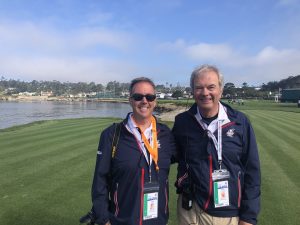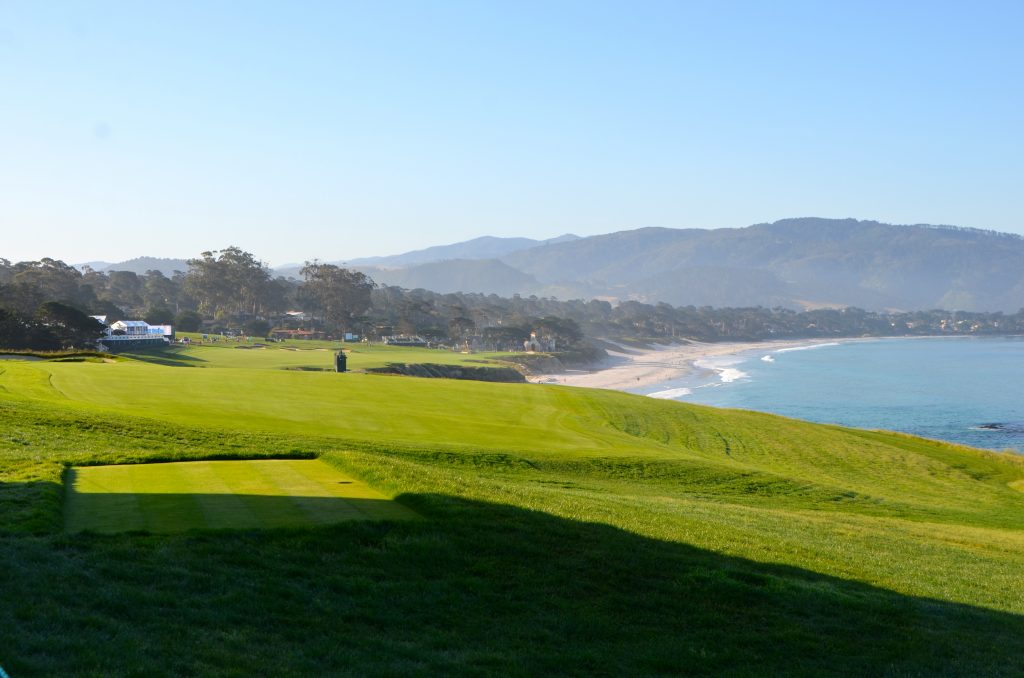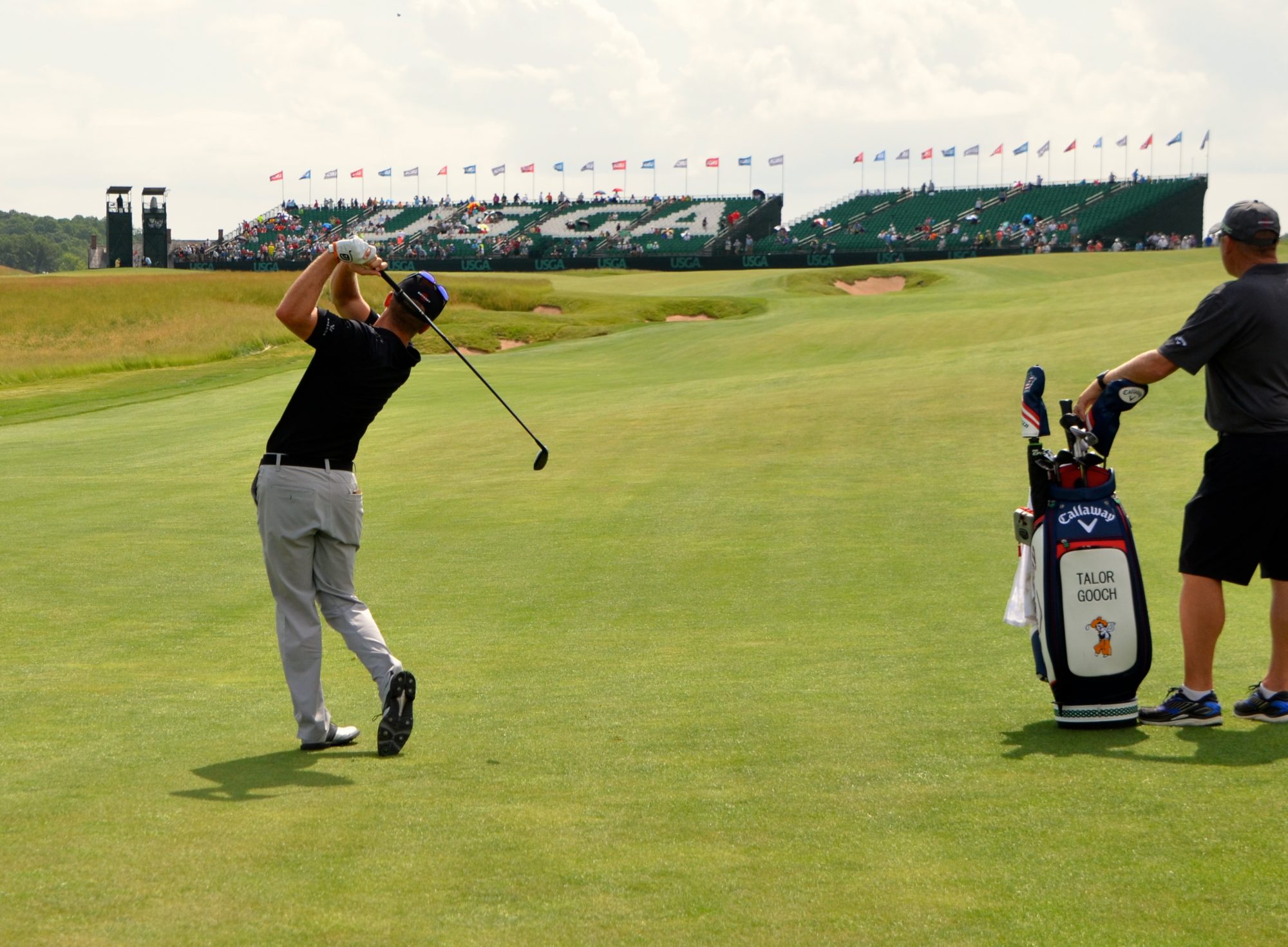While the U.S. Open may have been born along another ocean, on the other side of the American continent, when it returns to Pebble Beach it truly feels like something of a homecoming. The trophy looks at home on the first tee and our national championship itself feels tied to this part of the California coast, to this stretch of the Pacific Ocean, to this incredible place.
“It is an interesting biological fact that all of us have in our veins the exact same percentage of salt in our blood that exists in the ocean, and therefore, we have salt in our blood, in our sweat, in our tears. We are tied to the ocean. And when we go back to the sea… we are going back from whence we came.”
He wasn’t talking about the U.S. Open at Pebble, but I’d like to think John F. Kennedy would have understood the notion.
We know he knew our game as a member of the Harvard University golf team, we know he loved the ocean (and as President preserved 43,000 acres of beachfront as the Cape Cod National Seashore), and we know he played the game across the Monterey Peninsula – including a near hole-in-one on Cypress Point’s signature 16th hole just days before securing the Democratic nomination for President in 1960.
But as the 787 lifted off from SFO after a week at Pebble Beach for the 119th U.S. Open, his words exposed a bit of the meaning – maybe even a part of the purpose – that tied together so many of the characters gathered on the Pacific coast that week.
For my English golf scoring buddy, it was a lifetime dream to score the U.S. Open at one of the most beautiful golf courses on earth; for my college roommate’s son, it was likely the final time to carry the standard inside the ropes; and for an old boss and lifelong friend, it was her redemption at volunteering at Pebble Beach after a tennis injury sidelined her plans nearly a decade earlier.

Bob and I have scored tournaments together and volunteered in the Middle East, the United Kingdom and in the United States, but Pebble was the first time we both scored the men’s U.S. Open together – and it was exciting to share the training, the meetings, the meals and the stories over the course of the week. There’s a joy in watching someone you like do something you love for the first time – their wonder is reflected and their happiness contagious. My dad, with whom I attended my first U.S. Open nearly 20 years ago and started this journey with, has “retired” from volunteering and though he’s a bit younger than my dad, there’s a special feeling to sharing some of these experiences with Bob – the U.S. Open most of all.
And I’ve known Will since before he had any memories of his own. While I’ve watched him grow and mature – and even tagged along on a college visit – his dad and I have volunteered with him now at three U.S. Opens. Even though I was less than pleased he and I would share no rounds together as scorer and sign carrier, he walked with three other guys I know very well – all of whom he’d been inside the ropes with before at either Chambers Bay or Oakmont. Each remarked after the round how efficient and professional he was, how pleasant he was to spend the hours chatting with, and how much enjoyment they had sharing the time with him during each round. I would never have guessed that hearing them talk about Will would actually be more gratifying, more rewarding than if I’d had those experiences with him myself.
For during the week off the course he and I – sometimes with his dad (my college roommate) and sometimes without – would spend hours talking through life, about college, about hopes and dreams that were no longer distant but right around the corner. Sitting on the expansive balcony of the AirBnb as the Pacific beat upon the shore just below us, we talked about his friends, his excitement and his worries – some vague and some specific. He and his dad would leave Sunday to fly to Tucson so he could register for freshman year classes, scope out the campus and maybe drive by to check out fraternity houses.
And in fact there was someone along in our volunteer ranks – actually volunteering most days with Will’s dad as a 10th hole marshal – who I’d known even longer than Will. I’d met Judy 25 years earlier – my first boss when I arrived to work in Washington, DC, we’d since traveled around the world together with family and friends. Nine years earlier she’d signed up to volunteer at Pebble Beach with my mom, dad, and other friends before a knee injury dashed those plans.
This year tumbled down upon her far worse than any knee injury when just a few months before the U.S. Open she found her closest relative – her Army pilot nephew just barely in his 30s – dead in his home across the street from hers. The blood clot that ended his life threw hers into a spiral and very nearly derailed her plans to volunteer at Pebble Beach yet again. But she’s got the kind of spirit that won’t be denied – and despite all the personal grief and the physical trauma of preparing his house for sale – Judy was on that 10th tee box for her first shift soaking in every remarkable player that fired tee shots down that beautiful lush fairway hanging just above the beach and Carmel-by-the-Sea.
So while the people, the mighty ocean, some great food, stories and wine might have consumed the week – we were there for some golf as well.
In the first round I was scheduled to score I ventured out with two college dropouts and a guy who’d never even started college… but he’d since won the U.S. Open at Merion and a Gold Medal in the Olympics and the other two combined for 19 majors between them. It was the third time I’d scored Tiger Woods at the U.S. Open and the crush of media, the fans mobbing the rope lines, and the utter thrill of watching one of the greatest golfers of all time never gets old. Watching – and listening to – Jordan Spieth is a treat and experiencing the grace and skill of Justin Rose in a round of golf is always a personal pleasure.
But in what must always be earned and never taken for granted, on Sunday the USGA blessed me with a second late walk in as many years with Brooks Koepka in the final round. And if Judy was daily demonstrating the kind of spirit that wouldn’t be denied each day at Pebble, Brooks had a recent habit of bringing that to the course as well.
While he started four strokes behind Gary Woodland that afternoon, Koepka was gunning for an incredible three-peat of our national championship and my brain was flirting with a potential back-to-back scoring opportunity – especially as holes one through five exploded across the chilly, foggy start to the round.
The afternoon began with two decent drives from Koepka and playing partner Chez Reavie. Coming off the 1st tee, Brooks made at least a 30-yard detour to the right rope to give his dad a hug on Father’s Day before marching his way up to his ball in the first cut. A clean wedge to six feet set up his birdie on one.
A drive right of right, past the bunker and even the cart path, left his second hole tee shot buried in thick rough. Brute strength let him muscle the ball across the fairway, moderately forward, but led to a second shot in more gnarly rough just outside the sand in the ditch 100 yards from the green. With a big swing where almost anything could happen, Koepka did the absolute unbelievable, sticking the ball to within a foot of the hole and tapping in for a par that felt like a birdie after never sniffing the “must hit fairway.” The growing crowds went wild.
A one-foot tap-in for birdie on the third was followed by a five-footer for birdie on the fourth. Four holes into his Sunday round, Koepka had made four putts for no more than 13 or 14 feet total.
The marine layer might have been keeping everyone in quarter-zips, but the Pebble Beach crowds were four to five deep at the ropes and the place was vibrating with the kind of excitement we were beginning to expect from Brooks Koepka at the majors.
When his tee shot on the 204-yard fifth fed off the fringe to about 20 feet, the string of easy one-putts faltered… but his string of one-putts did not. Brooks was now four under through five holes, the crowds had grown to Tiger-like size, and the march up the hill to the 6th hole was utter chaos – running fans, screaming his name, the words “three-peat” repeated so loudly, so often it was just a continuous chant.
So when our little group stood on the 6th tee – the hole that scored the easiest in the 2000 U.S. Open and most thought was one of the best scoring opportunities on the course – the feeling was electric as Brooks hammered his tee shot dead center in the fairway. But after a wide right shot into the bunker on the approach from 200 yards, an out that left a 16-foot putt, and a roll that came up slightly short and right, it felt like something in the air changed. As much as the made bogey at Shinnecock on his 11th hole a year earlier felt like a rush of fresh, winning air, nothing felt quite right after that par on the 6th.
There was good golf – and actually quite fine golf from Chez Reavie – the rest of the afternoon but the magic of the start refused to be conjured again as we wound our way across the course.
After he signed his scorecard, Brooks Koepka was as polite as he always seems to be to the volunteers, handing me a signed ball with a “thank you” and autographing the USGA sign for the girl who carried the standard with us during the round. But you could sense the fire – and some frustration – that burns in him for majors just after the round and it was clear the passion and desire for the three-peat was just as intense in him as it was in the loud and hopeful crowds that cheered him from tee to green all day.
There was an odd mix of executives, pros, volunteers, media and others who shared our good fortune in having a pass to be near the 18th green as the final group played their closing shots. And so it was that U.S. Amateur champion and low amateur at the U.S. Open Viktor Hovland was just to my left; Justin Thomas, Jordan Spieth and Matt Kuchar and his wife just in front; and USGA President Mark Newell and half the Executive Committee to my right as Gary Woodland sunk his final shot – a 30-foot bomb of a putt – to claim victory by three strokes.
Standing there as the roars burst forth in the grandstands above us, I was happy for fellow volunteer Dave Belding who’d made the walking scorer journey with Woodland that day. Just a minor speck in a massive crowd, I stood taking in the sights, sounds and passion of the moment – listening to the crowd noise overpower the Pacific crashing just below us.
Those thoughts, the memories of so many wonderful people who’d been there for the week, and the words of JFK mingled in my brain not much more than 24 hours later as my eyes closed, the seat reclined and the United jet left the ground bearing east toward the Atlantic Ocean.
The very ocean the 35th President and I grew up within easy reach of – the ocean in sight of the first U.S. Open Championship. That ocean, the ocean of my youth was normally calm, with tranquil swells meeting sandy beaches that stretched for miles – whether it was Cape Cod, the Jersey shore or the low country of South Carolina… that was my ocean.
Last year with the smell of the Atlantic on every breath, I was fortunate enough to walk with Brooks Koepka on Sunday as he claimed his second U.S. Open trophy in as many years. But this year, along the rougher, jagged Pacific Coast, the week contained no profound glory, no historical achievement for the men I tracked inside the ropes. But there were – as there always are if you look closely enough – fragments of greatness. Those first five holes on Sunday by the second place finisher, the steady and sure golf Chez Reavie played all afternoon the same day (that would translate to victory just the next week), the handful of magical shots Tiger Woods mustered through his first 16 holes on Friday to the delight of massive, boisterous crowds.

And of course the salt water of the mighty Pacific – as it rolled into Carmel Bay and Stillwater Cove – mixed with the salt of Judy the 10th hole marshal’s tears of pain and in Bob the walking scorers’ tears of joy, it met the salt in Brooks Koepka’s sweat, and it was most definitely in the amped up blood of standard bearer Will as he plotted and planned for college course selection and the adventures ahead.
It may not be a biological fact that golf runs through our blood at the same percentage as the salt in the oceans, but for each of us – in our own unique and special way – the game of golf runs through our veins and serves as a mighty bond between us all.
There’s little doubt many of us will again be present the next time the U.S. Open returns to Pebble Beach. For in ways both seen and unseen, we are tied to that ocean, that place and that course.
